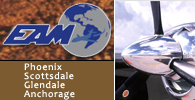 During your preflight inspection, don’t neglect to spend some quality time looking over the TPE331-5 or Dash 10T engines. Here are a few things to check before engine start:
During your preflight inspection, don’t neglect to spend some quality time looking over the TPE331-5 or Dash 10T engines. Here are a few things to check before engine start:
Check the inlet area for debris (especially around the inlet sensor), loose paint, and a deteriorating inlet gasket. Remove any debris and loose paint and trim gasket material if there’s a possibility that it may be ingested by the engine. Be sure to make a note to have your maintenance shop re-treat and paint the inlet, and replace the gasket at your earliest convenience.
Pull the prop through in the direction of travel at least 30 blades, for a couple of reasons. First, to scavenge oil from the gearbox back into the oil tank so you can accurately check the oil level. Be careful when checking the oil, however—if you remove the cap and oil spills out onto your shoes, the oil is over serviced; keep the level just at or slightly above the “ADD” mark on the stick.
Second, you need to listen for any strange noises. You may hear a “growl” sound or chatter, which is the backlash from the fuel pump, or a minor scraping sound. This usually is heard on a warm engine on which work has recently been done to the hot section, and the new seals need to be broken in. Both noises are normal.
If the engine is seized, it’s most likely due to shaft bow. Give it some time to cool down, and pull it through when it frees up to help dissipate the heat causing the problem.
You may notice a small puddle of oil in the engine inlet. If so, look for the source of the leak. If it coming from the throat of the inlet next to the impeller, then there is a compressor seal leak. This is not uncommon, and not cause for immediate repair. Compressor seals are allowed to leak 15 drops per minute when the engine is static. It will not leak while the engine is running due to the negative pressure atmosphere in the gearbox during operation.
However, if the compressor seal leak is bad enough it could cause the torque indication to be inaccurate and also allow oil to vent overboard when flying at altitude.
If the oil leak is coming from the top of the inlet smile near the gasket and drain, it is more than likely a prop shaft seal or prop flange O-ring; the maximum leakage allowed before maintenance is required is eight drops per hour. Check the inlet drain on every preflight because rain or an aircraft wash can cause water to accumulate in this area, resulting in a mess on your cowling during flight, or corrosion on the output housing if allowed to sit for an extended period of time.
Notice three separate lines coming from the drain mast on the underside of the engine cowling. The forward line is fuel, the middle is hydraulic fluid, and the aft line is oil.
If fuel is dripping from the forward line it could be coming from one of four components: the fuel pump, the fuel control unit (FCU), the start pressure regulator (SPR), or the plenum drain fittings. The allowable fuel leak limit when the airplane is static is 15 drops per minute. If you notice fuel leaking in flight your mechanic will have to isolate the component causing the leak and check the engine maintenance manual for limits (72-00-00 table 101).
If the middle drain line is leaking hydraulic fluid it indicates the pump shaft seal is going south and needs to be repaired. It’s best to get this repaired quickly since it may leak a little fluid statically, but when the engine is running the pump is sucking air through the bad seal and causing the hydraulic fluid to foam and possibly vent overboard.
The aft line will have traces of oil in it since it is the vent to the oil reservoir; excessive venting of oil is caused by over-servicing the oil or by an internal gearbox problem such as a bad compressor seal. If your main landing gear and gear doors are coated with oil, check your oil level.
The last engine preflight action is to shine a flashlight up the tailpipe. The aft turbine scavenge pump is located directly in the middle of the last (third) T-wheel, and it can develop leaks as well; it’s just harder to tell since the oil leaks into the hot exhaust. Look for carbon build-up on and around the aft circular access cover. Also, you may find the engine is consuming oil with no visible leaks anywhere else on the engine. The leak limit is one quart per 12.5 operating hours, but you will probably notice the carbon or even smoke in the exhaust before getting to that point.
While you’re looking at the aft turbine pump you can also check out the blades on the third T-wheel and the security of the exhaust pipe and seals. This is easier to do on the Dash 10T engines, but still visible on the Dash 5s, too.
Rob Louviaux, a 25-year-veteran of Twin Commander maintenance, is Aircraft Maintenance Manager at Executive Aircraft Maintenance in Scottsdale, Arizona.



